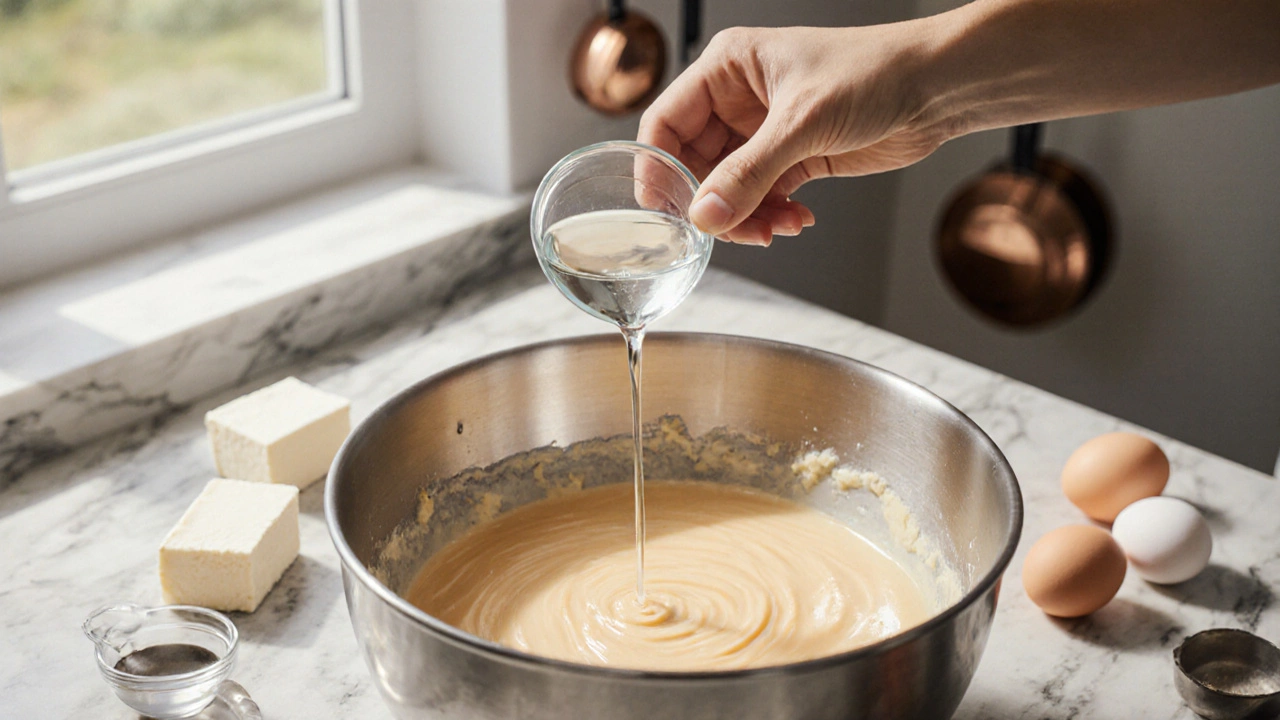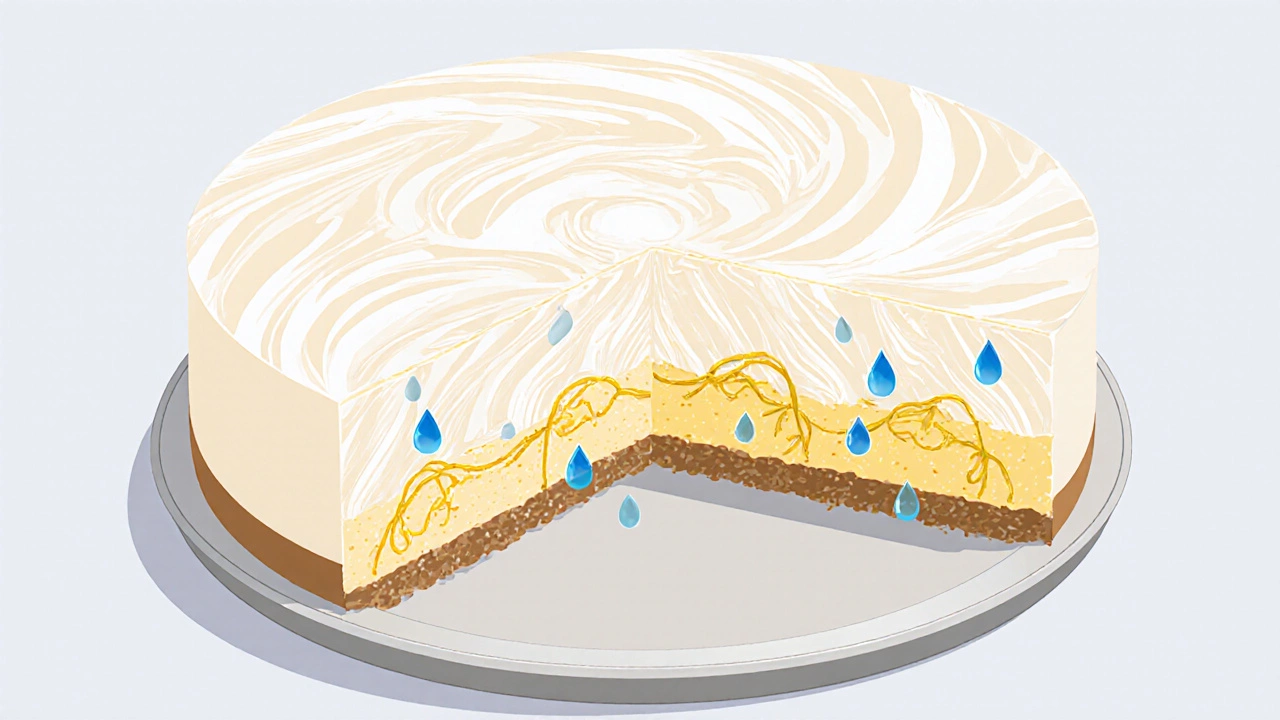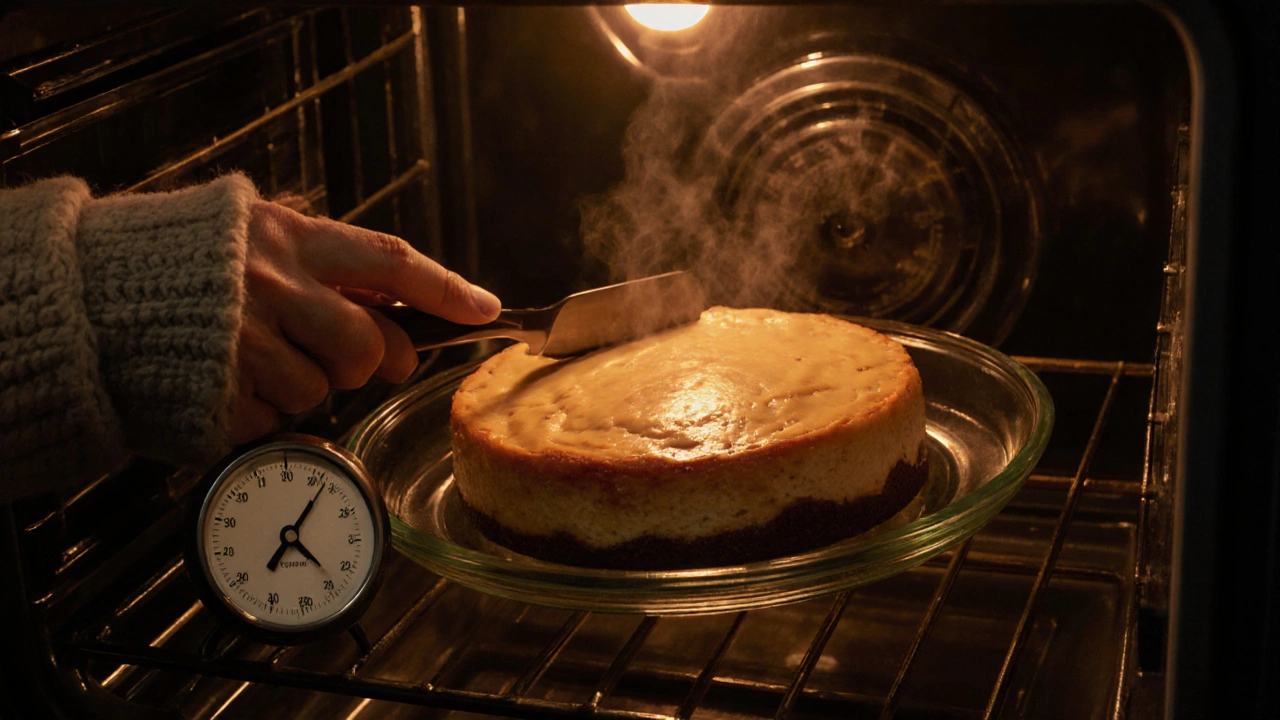
Cheesecake Vinegar Calculator
Calculate the perfect amount of vinegar for your cheesecake based on pan size. The article explains that 1 teaspoon per 24-ounce batter is recommended.
Recommended Vinegar Amount
For a 9-inch cheesecake (24oz batter)
Avoid red wine vinegar for classic cheesecakes as it can overpower the flavor.
Cheesecake Troubleshooting
Cracked top? Reduce bake time, ensure water bath, check vinegar amount.
Gummy center? Increase temperature by 10°F, verify vinegar amount, cool gradually.
Overly sour? Cut vinegar in half or switch to apple cider vinegar.
Dry texture? Lower bake time, add sour cream, avoid over-beating batter.
Ever wondered why a splash of vinegar in cheesecake shows up in so many recipes? It’s not a typo or a quirky tradition - the acid actually plays a crucial role in shaping the flavor, texture, and even the bake‑time of your dessert. This guide breaks down the chemistry, tells you exactly how much to use, which vinegar works best, and what to watch out for if you skip it.
Key Takeaways
- Vinegar adds a mild acidity that stabilizes the cheesecake batter and prevents cracking.
- Only 1‑2 teaspoons per 9‑inch pan are needed; too much can make the flavor sour.
- White distilled vinegar is the safest choice; milder flavored vinegars add subtle notes.
- If you omit vinegar, use a substitute like lemon juice or cream of tartar, but adjust the amount.
- Follow a simple troubleshooting checklist to rescue a gummy or cracked cheesecake.
What is vinegar a liquid acid made by fermenting ethanol, used for flavoring and preserving foods doing in a cheesecake a rich, creamy dessert made from a mixture of cream cheese, sugar, eggs, and a stabilizing base such as a crust?
Cheesecake is essentially a custard that needs a gentle setting process. The delicate proteins in cream cheese a soft, high‑fat cheese that provides the smooth body of a cheesecake and the eggs a binding agent that coagulates when heated, giving structure to baked goods can over‑coagulate, leading to a dry, grainy texture or cracks on the surface. A tiny amount of acid from vinegar does three things:
- Denatures proteins just enough to keep the batter smooth without over‑tightening.
- Balances sugar a sweetener that also influences the moisture balance in baked desserts acidity, preventing a sour taste while still giving a pleasant tang.
- Creates a slightly more acidic environment that helps the cake rise evenly, reducing the risk of a domed top that cracks when cooled.
In short, vinegar acts as a neutral‑pH buffer that fine‑tunes the chemistry without overwhelming the palate.

How Much Vinegar Should You Add?
The rule of thumb is 1 teaspoon of white distilled vinegar per 24‑ounce (about 680g) cheesecake batter. For larger 12‑inch pans, double the amount to 2 teaspoons. Anything beyond 1 tablespoon starts to introduce a noticeable tang that can mask the buttery notes of the crust.
Here’s a quick math cheat‑sheet:
- Standard 9‑inch springform (≈24oz): 1 tsp
- Mini 6‑inch (≈12oz): ½ tsp
- Large 12‑inch (≈48oz): 2 tsp
Measure with a regular teaspoon; shaking the bottle to settle the liquid ensures consistency. Add the vinegar to the wet ingredients before folding in the cream cheese - this guarantees even distribution.
Choosing the Right Vinegar
Not all vinegars are created equal. Some bring strong flavor notes that can clash with a classic cheesecake, while others are virtually neutral. Below is a comparison of the most common options.
| Vinegar | Acidity % | Flavor Profile | Best Use |
|---|---|---|---|
| White distilled | 5‑7% | Neutral, crisp | Standard recipes - no flavor interference |
| Apple cider | 5‑6% | Fruity, mild sweetness | When a subtle fruit tang is desired |
| Balsamic | 6‑7% | Rich, slightly sweet | Specialty cheesecakes with caramel or chocolate |
| Red wine | 5‑6% | Robust, tannic | Not recommended for classic styles |
For most home bakers, stick with white distilled vinegar. If you’re feeling adventurous, a half‑teaspoon of apple cider vinegar can add a whisper of fruit without overwhelming the classic flavor.
Common Pitfalls and How to Avoid Them
Even with the right amount of vinegar, a few mistakes can sabotage your cheesecake.
- Using too much acid: The batter becomes overly thin, leading to a soupy centre. Always measure precisely.
- Adding vinegar after the batter is already thick: It can create pockets of acidity, causing uneven texture. Mix it in early.
- Skipping the water bath (bain‑marie): Without the gentle, steady heat, the acid’s stabilizing effect is less effective, increasing the chance of cracks.
- Over‑baking: The acid helps, but if you bake too long, the cake dries out anyway. Test for a slight wobble in the center before removing from the oven.
By keeping these points in mind, you’ll harness vinegar’s benefits without the downsides.

Can You Skip the Vinegar?
Yes, but you’ll need a substitute to keep the protein structure in check. Here are three alternatives:
- Lemon juice: Use the same amount (1 tsp per 24oz). Provides a citrus note that pairs well with berries.
- Cream of tartar: Use ¼ tsp for the same effect; it’s a dry acid that won’t add liquid.
- Buttermilk: Replace 2 tbsp of cream cheese with 2 tbsp buttermilk; the extra acidity balances the batter.
Whichever you choose, adjust the flavor balance by tasting the batter before baking - a quick spoonful will tell you if the tang is too strong.
Cheesecake Troubleshooting Checklist
- Cracked top? - Reduce bake time, ensure a proper water bath, and double‑check vinegar amount.
- Gummy centre? - Increase oven temperature by 10°F, add the correct vinegar dose, and let the cheesecake cool gradually.
- Overly sour? - Cut vinegar in half or switch to a milder apple cider version.
- Dry texture? - Lower bake time, add a tablespoon of sour cream, and verify you didn’t over‑beat the batter.
Keep this list handy the next time your cheesecake misbehaves.
Frequently Asked Questions
Why does vinegar prevent cracks in a cheesecake?
A small amount of acid gently denatures the proteins in cream cheese and eggs, giving the batter a more flexible structure that can expand and contract without tearing the surface.
Can I use apple cider vinegar instead of white distilled?
Yes, but keep the quantity the same (1 tsp per 24oz). Apple cider adds a faint fruity note, which works well with caramel or pumpkin cheesecakes.
Is vinegar safe for a no‑bake cheesecake?
For no‑bake versions, you generally don’t need vinegar because the setting comes from gelatin or agar. Adding acid could make the texture too loose.
What if my recipe already calls for lemon juice?
You can skip the vinegar and just use the lemon juice as the acidic component. Adjust the volume so the total acidity stays around 1‑2 teaspoons per pan.
Does the type of crust affect how much vinegar I need?
Not really. The crust’s role is structural, while vinegar works inside the batter. Stick to the same dosage regardless of a graham, Oreo, or almond crust.
Armed with the science behind the splash of vinegar, you can bake cheesecakes that stay smooth, crack‑free, and perfectly balanced. Happy baking!